Terahertz Displacement and Thickness Sensor with Micrometer Resolution and Centimeter Dynamic Range
Abstract
:1. Introduction
2. Measurement Principles and Setup
2.1. Measurement of the Displacement and the Thickness
2.2. Design of the THz Displacement and Thickness Sensor
3. Experiments and Applications
3.1. Displacement Measurement Range Performance Comparison
3.2. Measurement Accuracy Evaluation of the THz Displacement Sensor
3.3. Simultaneous Displacement and Thickness Measurement
4. Conclusions
Author Contributions
Funding
Conflicts of Interest
References
- O’Hara, J.F.; Singh, R.; Brener, I.; Smirnova, E.; Han, J.; Taylor, A.J.; Zhang, W. Thin-film sensing with planar terahertz metamaterials: Sensitivity and limitations. Opt. Express 2008, 16, 1786–1795. [Google Scholar] [CrossRef] [PubMed]
- Strachan, C.J.; Rades, T.; Newnham, D.A.; Gordon, K.C.; Pepper, M.; Taday, P.F. Using terahertz pulsed spectroscopy to study crystallinity of pharmaceutical materials. Chem. Phys. Lett. 2004, 390, 20–24. [Google Scholar] [CrossRef]
- Kemp, M.C.; Taday, P.F.; Cole, B.E.; Cluff, J.A.; Fitzgerald, A.J.; Tribe, W.R. Security applications of terahertz technology. In Terahertz for Military and Security Applications; International Society for Optics and Photonics: Washington, DC, USA, 2003; pp. 44–53. [Google Scholar]
- Yang, X.; Zhao, X.; Yang, K.; Liu, Y.; Liu, Y.; Fu, W.; Luo, Y. Biomedical applications of terahertz spectroscopy and imaging. Trends Biotechnol. 2016, 34, 810–824. [Google Scholar] [CrossRef] [PubMed]
- Yassin, S.; Su, K.; Lin, H.; Gladden, L.F.; Zeitler, J.A. Diffusion and swelling measurements in pharmaceutical powder compacts using terahertz pulsed imaging. J. Pharm. Sci. 2015, 104, 1658–1667. [Google Scholar] [CrossRef] [PubMed]
- Hagelschuer, T.; Wienold, M.; Richter, H.; Schrottke, L.; Grahn, H.T.; Hübers, H.W. Real-time gas sensing based on optical feedback in a terahertz quantum-cascade laser. Opt. Express 2017, 25, 30203–30213. [Google Scholar] [CrossRef] [PubMed]
- You, B.; Ho, C.H.; Zheng, W.J.; Lu, J.Y. Terahertz volatile gas sensing by using polymer microporous membranes. Opt. Express 2015, 23, 2048–2057. [Google Scholar] [CrossRef] [PubMed]
- Lee, Y.S. Principles of Terahertz Science and Technology; Springer Science & Business Media: Berlin, Germany, 2009. [Google Scholar]
- Servagent, N.; Bosch, T.; Lescure, M. A laser displacement sensor using the self-mixing effect for modal analysis and defect detection. IEEE Trans. Instrum. Meas. 1997, 46, 847–850. [Google Scholar] [CrossRef]
- Zhang, Z.; Feng, Q.; Gao, Z.; Kuang, C.; Fei, C.; Li, Z.; Ding, J. A new laser displacement sensor based on triangulation for gauge real-time measurement. Opt. Laser Technol. 2008, 40, 252–255. [Google Scholar] [CrossRef]
- Nabavi, M.R.; Nihtianov, S.N. Design strategies for eddy-current displacement sensor systems: Review and recommendations. IEEE Sens. J. 2012, 12, 3346–3355. [Google Scholar] [CrossRef]
- Wang, H.; Feng, Z. Ultrastable and highly sensitive eddy current displacement sensor using self-temperature compensation. Sens. Actuators A Phys. 2013, 203, 362–368. [Google Scholar] [CrossRef]
- Baldwin, J.R.; Fox, M.D. Ultrasonic Displacement Sensor Using Digital Signal Processing Detection. U.S. Patent 7,027,355, 11 April 2006. [Google Scholar]
- Yin, W.; Peyton, A. Thickness measurement of non-magnetic plates using multi-frequency eddy current sensors. Ndt E Int. 2007, 40, 43–48. [Google Scholar] [CrossRef]
- Dixon, S.; Edwards, C.; Palmer, S. High accuracy non-contact ultrasonic thickness gauging of aluminium sheet using electromagnetic acoustic transducers. Ultrasonics 2001, 39, 445–453. [Google Scholar] [CrossRef]
- Yasui, T.; Yasuda, T.; Sawanaka, K.I.; Araki, T. Terahertz paintmeter for noncontact monitoring of thickness and drying progress in paint film. Appl. Opt. 2005, 44, 6849–6856. [Google Scholar] [CrossRef] [PubMed]
- Yasuda, T.; Iwata, T.; Araki, T.; Yasui, T. Improvement of minimum paint film thickness for THz paint meters by multiple-regression analysis. Appl. Opt. 2007, 46, 7518–7526. [Google Scholar] [CrossRef] [PubMed]
- Su, K.; Shen, Y.C.; Zeitler, J.A. Terahertz sensor for non-contact thickness and quality measurement of automobile paints of varying complexity. IEEE Trans. Terahertz Sci. Technol. 2017, 4, 432–439. [Google Scholar] [CrossRef]
- Han, D.H.; Kang, L.H. Nondestructive evaluation of GFRP composite including multi-delamination using THz spectroscopy and imaging. Compos. Struct. 2018, 185, 161–175. [Google Scholar] [CrossRef]
- Ens, J.; Lawrence, P. An investigation of methods for determining depth from focus. IEEE Trans. Pattern Anal. Mach. Intell. 1993, 15, 97–108. [Google Scholar] [CrossRef]
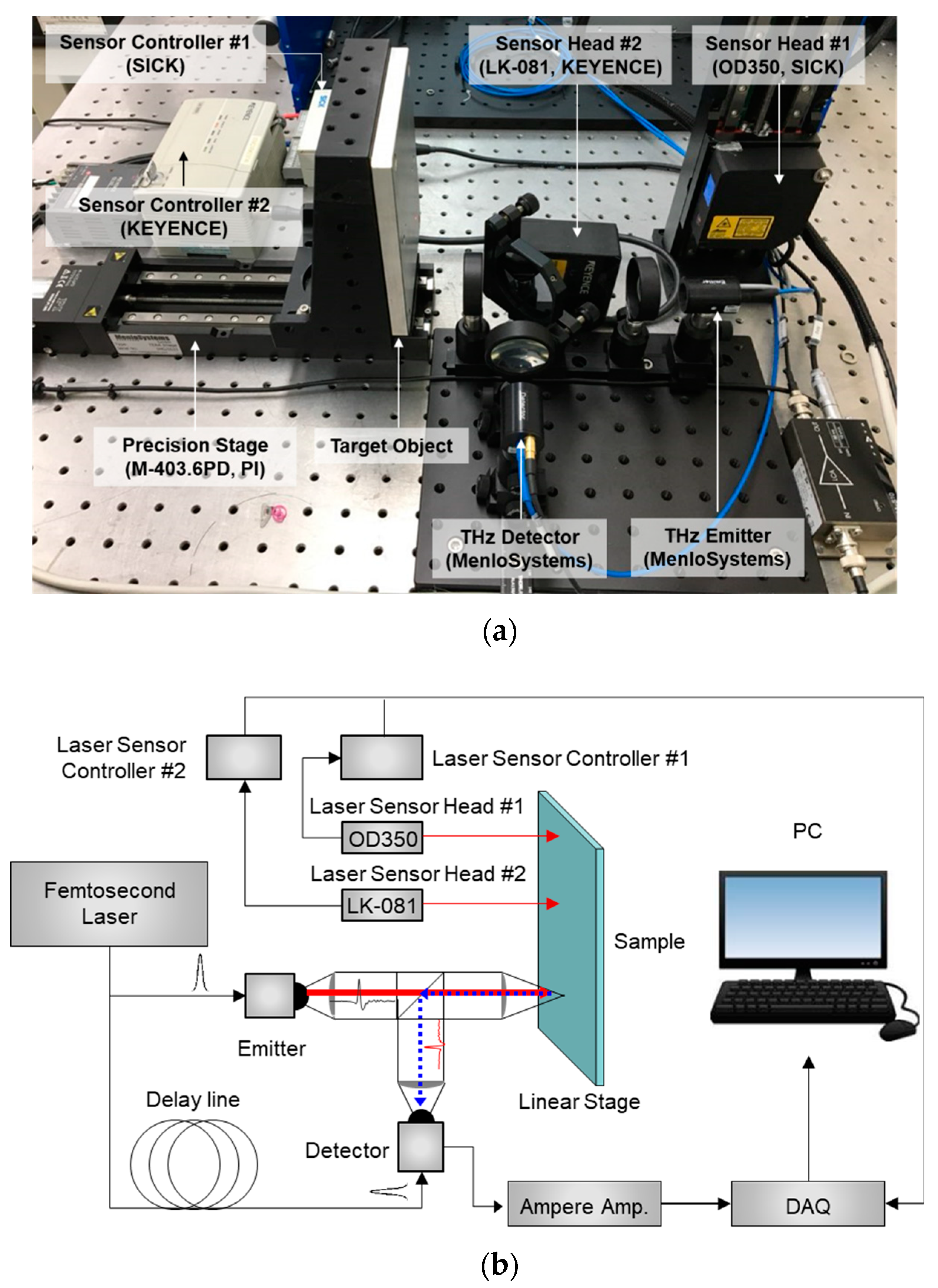
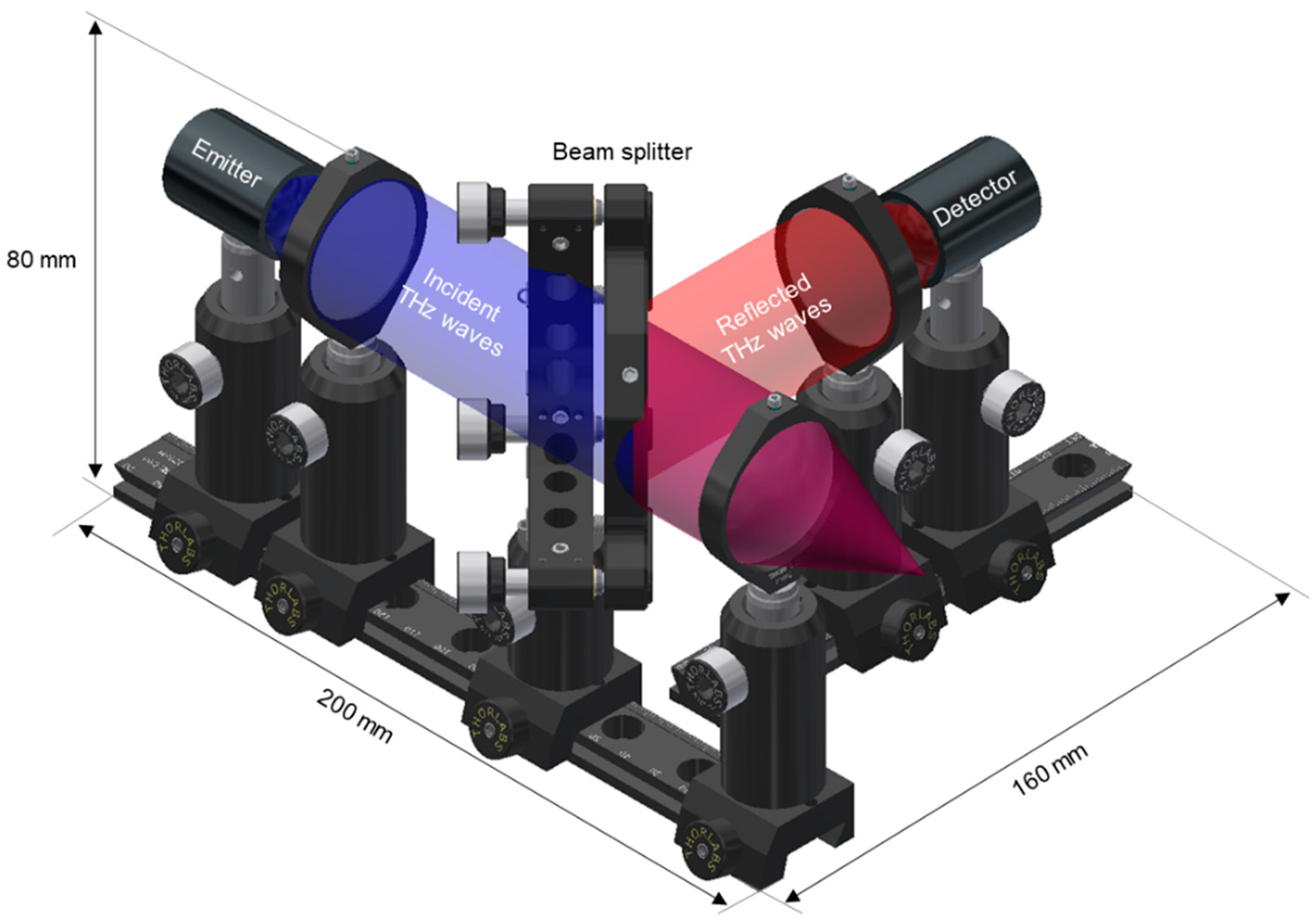

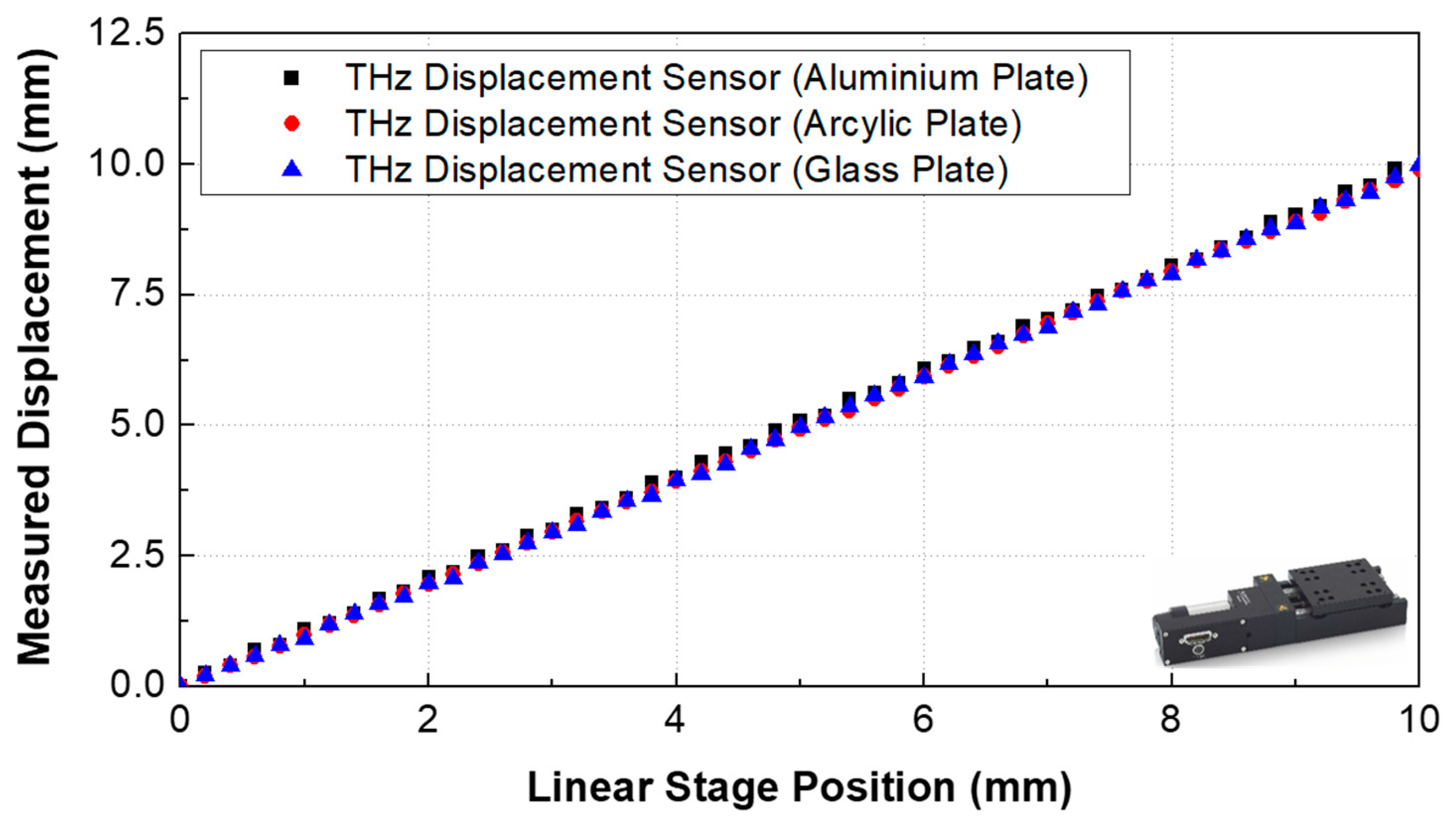


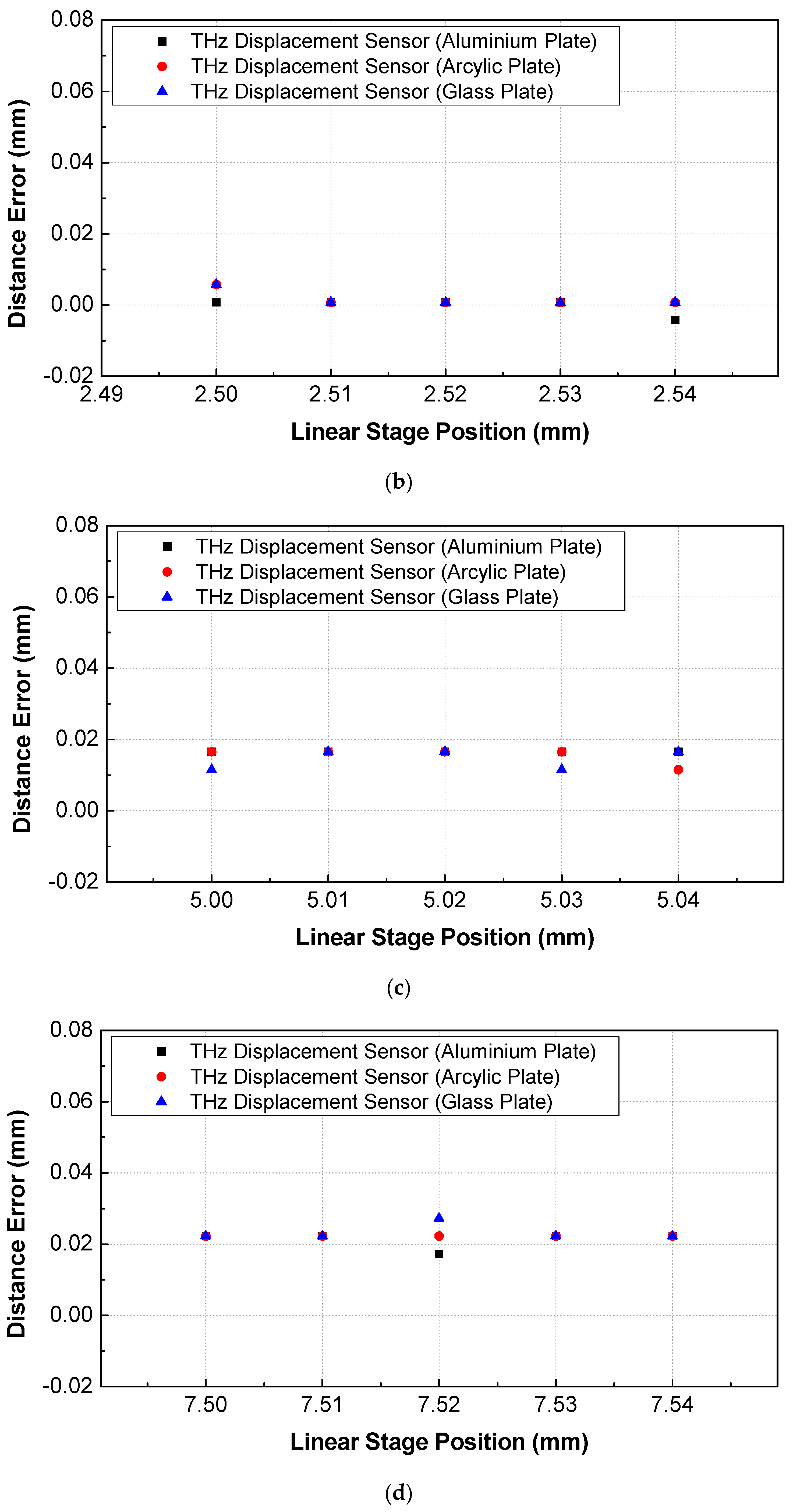

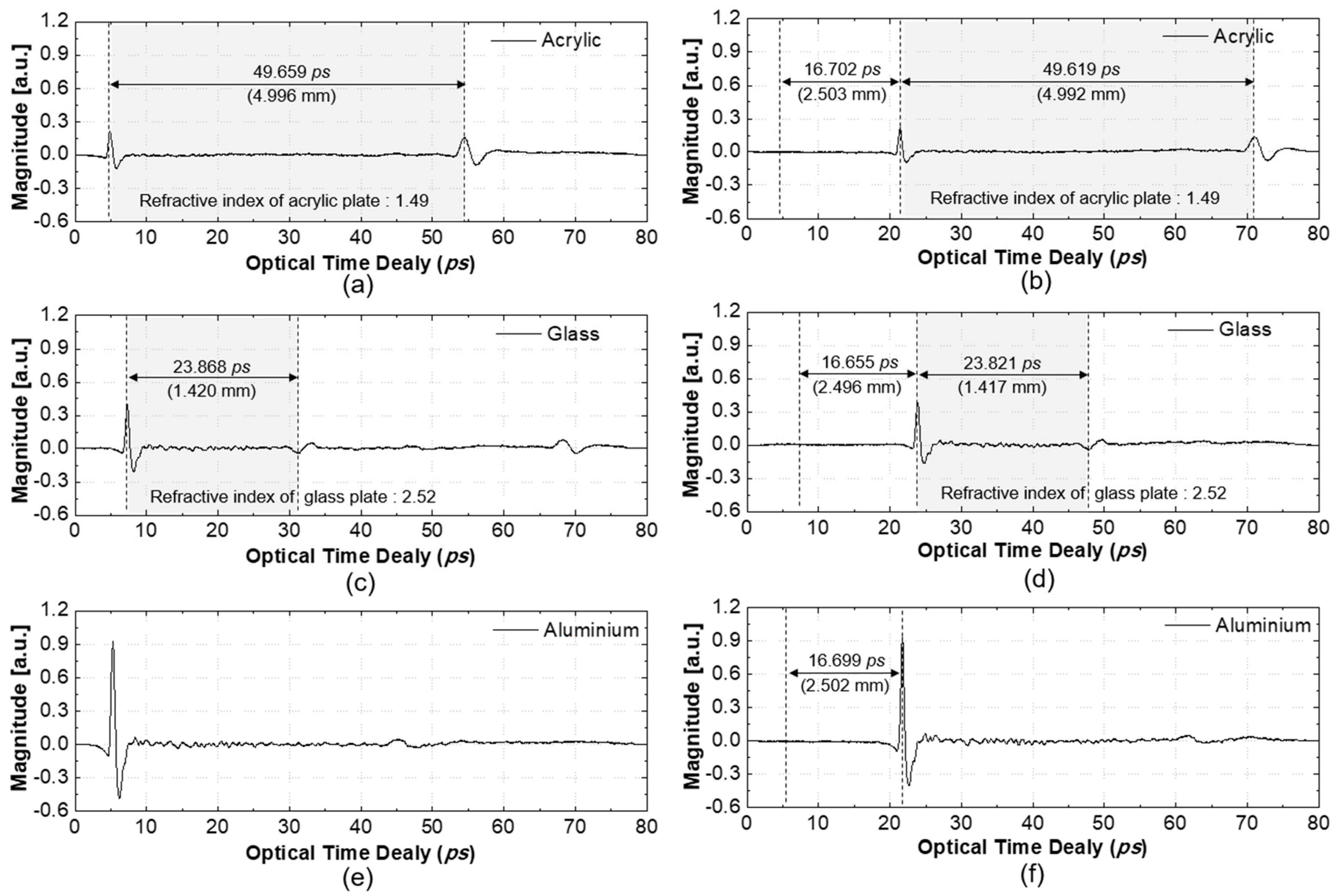
| Stage Disp.(mm) | Measured Displacement (mm) | Displacement Error (mm) | ||||
|---|---|---|---|---|---|---|
| Aluminum | Acrylic | Glass | Aluminum | Acrylic | Glass | |
| 0.00 | 0.000 | 0.000 | 0.000 | 0.000 | 0.000 | 0.000 |
| 0.01 | 0.005 | 0.010 | 0.010 | 0.005 | 0.000 | 0.000 |
| 0.02 | 0.020 | 0.020 | 0.020 | 0.000 | 0.000 | 0.000 |
| 0.03 | 0.030 | 0.030 | 0.030 | 0.000 | 0.000 | 0.000 |
| 0.04 | 0.040 | 0.045 | 0.040 | 0.000 | −0.005 | 0.000 |
| 2.50 | 2.499 | 2.494 | 2.499 | 0.001 | 0.006 | 0.001 |
| 2.51 | 2.509 | 2.509 | 2.509 | 0.001 | 0.001 | 0.001 |
| 2.52 | 2.519 | 2.519 | 2.519 | 0.001 | 0.001 | 0.001 |
| 2.53 | 2.529 | 2.529 | 2.529 | 0.001 | 0.001 | 0.001 |
| 2.54 | 2.544 | 2.539 | 2.539 | −0.004 | 0.001 | 0.001 |
| 5.00 | 4.939 | 4.959 | 4.984 | 0.017 | 0.017 | 0.017 |
| 5.01 | 4.954 | 4.969 | 4.994 | 0.017 | 0.017 | 0.017 |
| 5.02 | 4.964 | 4.979 | 5.009 | 0.017 | 0.017 | 0.012 |
| 5.03 | 4.974 | 4.989 | 5.014 | 0.017 | 0.017 | 0.017 |
| 5.04 | 4.989 | 4.994 | 5.023 | 0.017 | 0.012 | 0.017 |
| 7.50 | 7.483 | 7.478 | 7.483 | 0.022 | 0.022 | 0.017 |
| 7.51 | 7.493 | 7.488 | 7.493 | 0.022 | 0.022 | 0.017 |
| 7.52 | 7.503 | 7.498 | 7.503 | 0.017 | 0.022 | 0.017 |
| 7.53 | 7.513 | 7.508 | 7.513 | 0.022 | 0.022 | 0.017 |
| 7.54 | 7.523 | 7.518 | 7.523 | 0.022 | 0.022 | 0.017 |
| 9.96 | 9.927 | 9.932 | 9.937 | 0.033 | 0.028 | 0.023 |
| 9.97 | 9.937 | 9.942 | 9.947 | 0.033 | 0.028 | 0.023 |
| 9.98 | 9.947 | 9.952 | 9.962 | 0.033 | 0.028 | 0.018 |
| 9.99 | 9.957 | 9.967 | 9.967 | 0.033 | 0.023 | 0.023 |
| 10.00 | 9.962 | 9.977 | 9.977 | 0.038 | 0.023 | 0.023 |
| Target Materials | Thickness (mm) | ||
|---|---|---|---|
| THz Thickness Sensor | Thickness Gauge | ||
| Acrylic plate | at 0 mm | 4.996 | 5.000 |
| at 2.5 mm | 4.992 | ||
| Glass plate | at 0 mm | 1.420 | 1.420 |
| at 2.5 mm | 1.417 | ||
© 2019 by the authors. Licensee MDPI, Basel, Switzerland. This article is an open access article distributed under the terms and conditions of the Creative Commons Attribution (CC BY) license (http://creativecommons.org/licenses/by/4.0/).
Share and Cite
Han, D.-H.; Kang, L.-H. Terahertz Displacement and Thickness Sensor with Micrometer Resolution and Centimeter Dynamic Range. Sensors 2019, 19, 5249. https://doi.org/10.3390/s19235249
Han D-H, Kang L-H. Terahertz Displacement and Thickness Sensor with Micrometer Resolution and Centimeter Dynamic Range. Sensors. 2019; 19(23):5249. https://doi.org/10.3390/s19235249
Chicago/Turabian StyleHan, Dae-Hyun, and Lae-Hyong Kang. 2019. "Terahertz Displacement and Thickness Sensor with Micrometer Resolution and Centimeter Dynamic Range" Sensors 19, no. 23: 5249. https://doi.org/10.3390/s19235249
APA StyleHan, D.-H., & Kang, L.-H. (2019). Terahertz Displacement and Thickness Sensor with Micrometer Resolution and Centimeter Dynamic Range. Sensors, 19(23), 5249. https://doi.org/10.3390/s19235249





